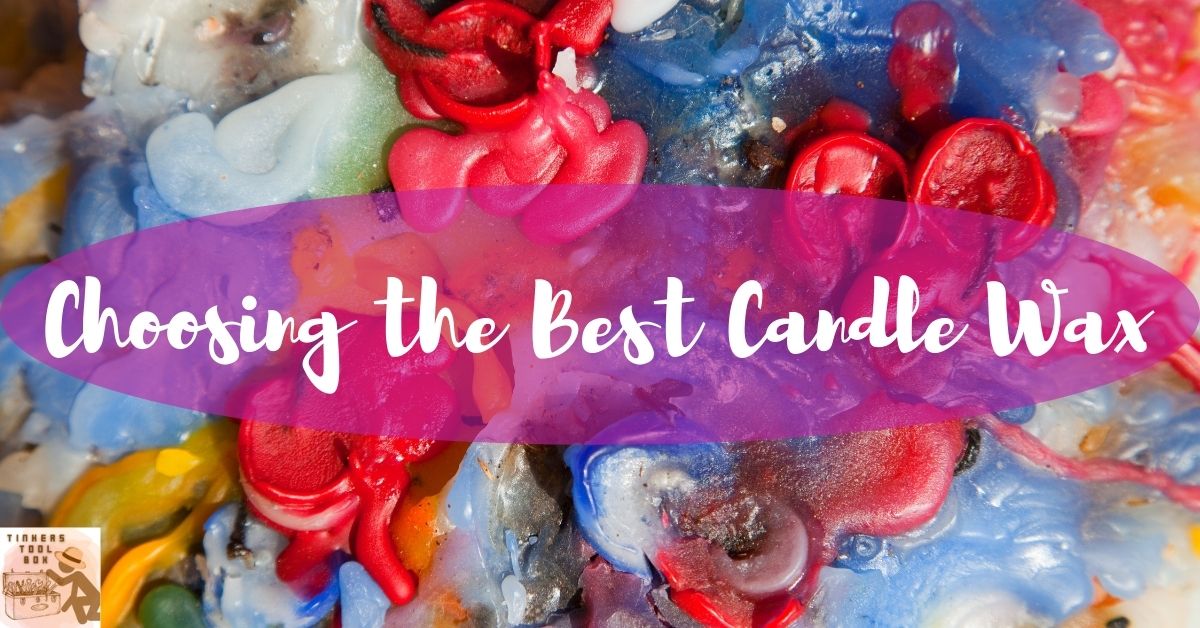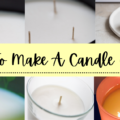When it comes to candle-making, you always have to start with the basics. The very first thing that you should know is how to pick the right candle wax for your candle-making project. Each type of wax matches the different types of candles that you would make for your candle-making journey.
Paraffin and palm are great for pillars and votives. Soy wax is great for slow-burning candles and is more affordable than other types of waxes. Coconut is great for container candles, while beeswax is great for all types of candles. Gel candle wax is great for clear glass containers since it has a translucent quality of gelatin.
If you want to create the best candles possible for your candle-making projects, you have to make sure you use the right type of wax. In this article, I will talk about the different wax types available for candle-making and what type of candles they match. I will also talk about what candle wax is made from and what other things that you should consider when choosing the best type of wax for your candle-making project.
The Different Types of Candle Waxes to Choose From

The different types of candle waxes that you can choose from for your candle-making projects are paraffin, palm, soy, coconut, beeswax, and gel candle wax. There are types of wax that are synthetics while others are natural. However, each type of wax has its own unique properties.
Paraffin Wax: Inexpensive Choice of Wax
Paraffin wax is the most used type of wax for candle-making because it is inexpensive. It is used across different candle brands because it can hold a high amount of colors and fragrances. Using this wax type also comes in different melt points, making it great for creating different types of candles.
This type of wax is long valued because of its opacity, lack of color, lack of odor, and consistent burn qualities. You can do so much when it comes to paraffin wax. With the different melting points it can achieve, they are great for candles such as pillars, votives, and containers.

Paraffin wax is also excellent for cold and hot throws. The best thing about this wax type is that it is widely available, so anyone can have access to them to create the candle they want.
Even though it is not universally embraced by candle makers today, paraffin wax is a by-product of the crude oil refinement process. It is made from petroleum which is called a carcinogen. Due to this feature, plenty of people tend to avoid this type of wax.
Aside from that, paraffin wax also creates smoke and soot. It is also fast-burning which means that paraffin candles do not last as long as other types of waxes. When you make a mess with paraffin candles, it can be very difficult to clean up.
Overall, there are plenty of other options for making candles available to candle makers today. There are rumors that are floating about that new non-toxic food-grade paraffin wax coming on the market.
Coconut Candle Wax: Great for Container Candles
Coconut candle wax is derived from coconuts that provide a sustainable high yield crop and hydrogenated into a waxy solid that is similar to how soy candles are made. It is also relatively soft and creamy, just like virgin coconut oil.
Now, coconut candle wax has a lower melt point compared to other types of wax. It makes it ideal for making essential oil candle-making or for making the candle-making process faster in general. Even though coconut candle wax is new to the candle world, it has become popular, and candle makers have been seeing it used in more premium candle brands.

Plenty of candle makers find it worth the cost since it provides an even burn, great scent throw, and ease of use. Aside from that, coconut candle wax is eco-friendly, all-natural, and plant-based. It also provides a smokeless and clean burn.
The best part about using coconut candle wax is it is slow-burning, which means your candle will last longer. It is great for making container candles and very easy to clean up.
The downside to this wax type is it is the most expensive candle wax type. Unlike paraffin, coconut candle wax is difficult to find as it is considered a new wax type. Also, it is not available at different melting points, which can be difficult when it comes to making candles.
Soy Candle Wax: Another Type of Wax that’s Great for Container Candles
Soy candle wax was created back in 1996 as an alternative to petroleum-derived paraffin. It came from a vegetable wax derived from 100 percent soybean oil. This type of wax is made of harvested soybeans that are cleaned, dehulled, rolled into flakes, and cracked.
The soybean oil is extracted from the said flakes and then hydrogenated. It is similar to the process of making vegetable cooking oils, and the result is a natural wax that solidifies when placed at room temperature. Once the entire process is finished, it is ready for your candle-making projects.

Soy candle wax has become increasingly popular throughout the years, as well as the demand for natural candles. Plenty of brands choose to only work with soy wax since it is best for container candles. It is one of the best candle wax types there is in the market.
It is environmentally friendly, natural, biodegradable, and renewable. Aside from that, it offers a smokeless burn, and just like coconut wax, it has a slow burn. The best thing about this wax type is it’s available at different melting points.
Soy candle wax is also more affordable than other natural candles on the market and is widely available. It is easy to color and easy to clean up.
When it comes to this wax type, there is no disadvantage since it is, in my opinion, the best wax material on this list.
Beeswax: Great for All Types of Candles
If coconut candle wax is the new type of wax, beeswax is the ancestor of all candle-making. This material dates back to the ancient Egyptians, which means it has been used for 5,000 years in plenty of candle projects. Bees excrete beeswax into the honeycombs.
When it is harvested from the beehive, beeswax is then melted and filtered into blocks, pastilles, or sheets. You will find many varieties available in different shades of gold or white, which are then bleached and dyed in different colors.
Beeswax has a high melting point, unlike the types of wax that are listed above, but the pastilles are very easy to melt, measure, as well as work with to create your candle-making projects. On the other hand, the pre-rolled beeswax sheets don’t need to go through the process of melting to make candles.

Since beeswax is naturally sourced from honeycombs, it is infused with honey and, in turn, has a sweet fragrance. The fragrance varies depending on the plants and flowers the bees consume. With beeswax, you can get scents like lavender, wildflower, and other types of honey.
It provides a smokeless, soot-free burn and has a unique golden color and natural honey scent. With this, you don’t need to worry about coloring your candles or adding fragrances to them. Beeswax is great for making pillars, votives, and container candles.
Now, they are more expensive than soy or paraffin waxes. It also doesn’t hold scents as well as the other candle wax types, and with its natural color, it can be difficult to add color to its natural golden hue. Aside from these disadvantages, I still consider beeswax as the second-best candle wax on this list.
Palm Wax Candles: Great for Pillars and Votives

Another type of natural wax is palm wax, which is also fairly new to the different types of wax available. It is a plant-based wax that is made from palms and processed into wax just like soy. Palm wax is hard compared to coconut wax, so it does well with pillars and votives.
Interestingly, palm wax naturally creates feathering and crystal-like patterns on the candle’s surface. The patterns on these types of wax are more prevalent in colored candles, and it takes color very well. Palm wax is also smokeless and soot-free burn.
The downside to palm wax is it is one of the more expensive candle wax types on this list. Also, it isn’t easy to find since it’s new to the market.
Gel Candle Wax: Often Used for Candle Crafting

Gel candle wax is often used for candle-making because it is easy to use. There is no need to meet this type of wax which is great! It is made from 140 degrees melting point paraffin that has been formed into tiny beads. All you need to do is pour the granulated wax into a container and insert the wick.
After that, you are good to go, and you will have a beautiful candle!
What to Consider When Choosing the Best Candle Wax for Candle-Making
Now, you want to first decide what type of candle you want to make before choosing your type of wax. The wax type that you will choose will depend on whether you are making a pillar candle, votive candle, container candle, tea lights candle, or taper candle.
Considering the Melting Point of the Wax

One of the factors that you would need to consider when picking what type of wax to use is the melting point. When you are in a hot climate or when you are planning to send your candle to a friend in a hot climate, the melting point is crucial.
You would not make a 100 percent coconut or even a low-melting paraffin candle during the hot summer months.
Make Sure the Shelf Life is Long
Now, each type of wax has a different shelf life and duration. Beeswax, for instance, has a long shelf life, takes a long time to make, and is considered as rare. Soy is more common but has a shorter shelf life than beeswax. Gel wax, on the other hand, has no expiration date.
Consider the Price of Each Candle Wax

Since beeswax usually takes longer to make and is considered as rare, it is much more expensive than other types of waxes. Soy wax and paraffin are more affordable since they are readily available. Now, the price point of waxes can vary.
So the number one determining factor in choosing your wax will be your budget. You would need to consider how much you are willing to spend on your candle project. There are some types of waxes that are very high-end, and you can also buy more common waxes that are more affordable.
Fragrance Load and Cold or Hot Throw of Candle Wax
It is important to know how easy or difficult it is to combine a particular wax with a fragrance. Beeswax has a distinct honey smell, and it is difficult to combine it with different fragrances to get a good cold/hot throw.
Other waxes can be combined with fragrances and essential oils easier than beeswax. Some waxes also require a higher fragrance load where the fragrance load is the percentage of fragrance you will add to the wax to get the cold and hot throw that you want.
All-Natural Product Candle Waxes
There are four types of all-natural waxes which are soy, beeswax, and coconut wax. They are considered to be natural because they come from ‘natural’ substances of the earth, such as soybeans, bees, coconuts, and palm berries.
Vegan-Friendly Candle Waxes

If it is important to you that your waxes are vegan-friendly, you have five options which are paraffin, gel, palm, or coconut wax. However, what you need to keep in mind when using vegan-friendly wax is you need to add additives to your wax or purchase a pre-made wax blend. At this point, it may no longer be ‘vegan.’
As candle makers, it is a common practice to add UV inhibitors, stearic acid, or other additives to the wax to help increase particular qualities or characteristics of a candle. These characteristics include appearance, hot or cold throw, and UV protection or color fading.
With this said, I’m not so sure whether you can have candles that are all-natural or vegan-friendly when you are adding these types of chemicals to them. Another option that you can go for that is more vegan-friendly is to use essential oils rather than fragrances in adding scents to your candles.
Know the Difference Between Soy Wax and Coconut-Paraffin Blend
Most candle makers start with making the container candles first since it is the easiest, to begin with when it comes to learning the candle-making process. At most times, the candle-making kits that you will be purchasing already include the containers.
To make other types of candles, like pillars and votives, can be a little bit more complicated and will require some finesse to handle. This is why choosing the right type of wax is crucial when you are making this type of candle.
Soy wax is the easiest wax to work with since it has a reasonable melting temperature and combines fairly easily with fragrances. It is also the most common appeal when it comes to the quality of candles which is why candle-makers prefer to work with this type of wax.
On the other hand, the coconut-paraffin blend was designed to specifically used in container candles. With this combination, you can create a great throw scent of paraffin with a slow burn rate of coconut. The coconut-paraffin blend has excellent glass adhesion, which seems to work well with any type of wick that you want to use.
FAQs
What Candle Wax Will Last the Longest?
When you want a candle that will last for a while, it is best to choose beeswax and soy wax as they last longer than the other types. Both types of wax have a slow burn and will burn for long periods of time. In comparison, soy wax candles will burn up to 50 percent longer than paraffin candles.
The reason for this is soy has a cooler burn temperature and lower melting point. It is not uncommon to find soy candles that are labeled with a 50 hour burn time.
Now, the length of time a candle burns can be greatly affected by different things such as the container, fragrance load, or candlewick.
Mixing Different Candle Wax: Is it Possible?

Most definitely! You can mix different candle waxes together, and some of the best candles are made from blending them. The most common candle blend is soy and paraffin wax. It is typically blended to cut costs by different manufacturers.
Also, the trade allows candles to be labeled as soy when it contains at least 51 percent of soy wax. This is another great reason to make your candles, so you know what you are actually getting.
Other blends that are quite popular are soy and coconut wax, coconut and beeswax, soy and palm wax, beeswax and coconut and soy wax. When combining candle waxes, you can have the best each has to offer.
The Type of Candle Wax that Has the Most Scent
One of the best wax for distributing a strong scent throw is paraffin wax. However, due to the soy wax’s density and lower burn temperature, it distributes scent more evenly. It can also last up to 50 percent longer than other candles that are made from paraffin wax.
It’s Time to Decide What Type of Wax to Use
The type of wax you will be using would really boil down to your personal preference, and it would depend on the type of candle you will be making. It would also depend on how much you want to spend, what strength of fragrance you prefer, and how conscious you are when it comes to the environment.
In the end, each of the wax types has its own disadvantages and advantages. What you should remember is that no matter what you choose, the combination of wax, grade of fragrance, vessel, and wick are all extremely important to the overall quality of your candle-making projects.















